THE crowd for Speed Week was a record in 2018, as was the number of entrants, the number of runs and the outright speeds achieved. The volunteer-run Dry Lakes Racers Australia has much to be proud of. It’s not every year that specialised streamliners travel halfway around the world with genuine ambitions of not only exceeding world land speed records but smashing them. I wasn’t the only one to make the trek to isolated Lake Gairdner, deep in the South Australian outback, to see them do just that or die trying.
 The world land speed record for a piston-powered wheel-driven streamliner is a two-way average of 439mph achieved by George Poteet in his Chev-powered Speed Demon at Bonneville in 2012, with a best one-way run of 451mph. For metric folk, that’s 706km/h and 725km/h respectively. Turbine and jet-powered cars have gone faster, but then so have aeroplanes – real cars have V8s.
The world land speed record for a piston-powered wheel-driven streamliner is a two-way average of 439mph achieved by George Poteet in his Chev-powered Speed Demon at Bonneville in 2012, with a best one-way run of 451mph. For metric folk, that’s 706km/h and 725km/h respectively. Turbine and jet-powered cars have gone faster, but then so have aeroplanes – real cars have V8s.
 Target 550 is a 13m-long, 1m-wide low-flying missile purpose-built to beat George’s record and then some, with widely publicised aspirations of being the first car to exceed 500mph and eventually 550mph. Powered by twin Whipple-blown 510ci V8 Hemis, each good for around 2500hp on alcohol, it’s not short of poke, which is just as well. Lake Gairdner is just 120m above sea level, whereas the Bonneville salt flats are 1300m above sea level. The air is much thicker here, much harder to punch through, but it’s not like US-based Target 550 partners Marlo Treit and Les Davenport have much choice. Bonneville is stuffed for now, at least for the fast guys. There’s not enough salt for them to get up to speed and slow down again. Whereas the salt at Lake Gairdner is 160km long. It’s worth a punt.
Target 550 is a 13m-long, 1m-wide low-flying missile purpose-built to beat George’s record and then some, with widely publicised aspirations of being the first car to exceed 500mph and eventually 550mph. Powered by twin Whipple-blown 510ci V8 Hemis, each good for around 2500hp on alcohol, it’s not short of poke, which is just as well. Lake Gairdner is just 120m above sea level, whereas the Bonneville salt flats are 1300m above sea level. The air is much thicker here, much harder to punch through, but it’s not like US-based Target 550 partners Marlo Treit and Les Davenport have much choice. Bonneville is stuffed for now, at least for the fast guys. There’s not enough salt for them to get up to speed and slow down again. Whereas the salt at Lake Gairdner is 160km long. It’s worth a punt.
 We can only imagine the logistics, red tape and expense involved in shipping a streamliner to Australia, let alone Lake Gairdner out in the middle of nowhere. And the risk. Speed Week has been washed out six times in its 28-year history, and there are no rain dates. Yet here they are. The salt is dry and hard, the sky is blue, but the breeze is up. Like a lot of the fast guys, Treit and Davenport sit out the first day waiting for the wind to ease off.
We can only imagine the logistics, red tape and expense involved in shipping a streamliner to Australia, let alone Lake Gairdner out in the middle of nowhere. And the risk. Speed Week has been washed out six times in its 28-year history, and there are no rain dates. Yet here they are. The salt is dry and hard, the sky is blue, but the breeze is up. Like a lot of the fast guys, Treit and Davenport sit out the first day waiting for the wind to ease off.
 After 60,000 man-hours and 11,000 miles, Target 550 finally makes its way to the Track 1 startline late on Tuesday morning, suspended from a cradle that they’ll also use to retrieve it after the run. A big crowd assembles as the cradle lowers the streamliner onto the salt for the first time and the crew undertakes final pre-flight inspections. This is the moment we’ve all been waiting for… when the starters announce the track will be closed for an hour while they break for lunch. How very Australian! The volunteer starters have been out there since 8am, so what is potentially the fastest car in the world will just have to wait like everyone else.
After 60,000 man-hours and 11,000 miles, Target 550 finally makes its way to the Track 1 startline late on Tuesday morning, suspended from a cradle that they’ll also use to retrieve it after the run. A big crowd assembles as the cradle lowers the streamliner onto the salt for the first time and the crew undertakes final pre-flight inspections. This is the moment we’ve all been waiting for… when the starters announce the track will be closed for an hour while they break for lunch. How very Australian! The volunteer starters have been out there since 8am, so what is potentially the fastest car in the world will just have to wait like everyone else.
 The other streamliner is Team 7, a motorcycle built and managed by Denis Manning, and ridden by America’s ‘Queen of Speed’, Valerie Thompson. Powered by a 500hp three-litre turbocharged V4, the bike (previously known as BUB Seven) is a former world record holder at 350mph in 2006 and 367mph in 2009 with rider Chris Carr. The current world motorcycle land speed record is 376mph, set by Rocky Robinson riding Ack Attack in 2010. Valerie’s best to date is 304mph at Bonneville, her speed limited by the condition of the salt. Manning says the bike is capable of 400mph if the conditions are right.
The other streamliner is Team 7, a motorcycle built and managed by Denis Manning, and ridden by America’s ‘Queen of Speed’, Valerie Thompson. Powered by a 500hp three-litre turbocharged V4, the bike (previously known as BUB Seven) is a former world record holder at 350mph in 2006 and 367mph in 2009 with rider Chris Carr. The current world motorcycle land speed record is 376mph, set by Rocky Robinson riding Ack Attack in 2010. Valerie’s best to date is 304mph at Bonneville, her speed limited by the condition of the salt. Manning says the bike is capable of 400mph if the conditions are right.
Like Target 550, the actual world record attempt – the average of two runs in opposite directions – will occur on a special 12-mile track at a separate internationally sanctioned event (also run by the DLRA) the following weekend, but both teams are keen to have a crack at some long-standing Aussie one-way records too. Team 7 is even more susceptible to wind than the car, and it isn’t until Thursday that Valerie fronts the starter for the first time, again to a big crowd.
 Davenport and Thompson are just two of a record 232 entrants in 2018, of whom more than 60 are rookies. The 2005 film The World’s Fastest Indian, starring Sir Anthony Hopkins as legendary Kiwi land speed racer Burt Munro, has led to a huge explosion of interest in salt racing amongst the motorcycle community, which now accounts for around three-quarters of Speed Week participants. This has changed the character of the event, but riders pay just as much to race as drivers, leading to an influx of funds that the DLRA has put to good use. The bike guys and gals have also dramatically increased the number of available volunteers. The five-day meeting runs like clockwork, hosting a record 850 individual runs on two tracks, 200 on the first day alone. Some 80 new car and bike records are set.
Davenport and Thompson are just two of a record 232 entrants in 2018, of whom more than 60 are rookies. The 2005 film The World’s Fastest Indian, starring Sir Anthony Hopkins as legendary Kiwi land speed racer Burt Munro, has led to a huge explosion of interest in salt racing amongst the motorcycle community, which now accounts for around three-quarters of Speed Week participants. This has changed the character of the event, but riders pay just as much to race as drivers, leading to an influx of funds that the DLRA has put to good use. The bike guys and gals have also dramatically increased the number of available volunteers. The five-day meeting runs like clockwork, hosting a record 850 individual runs on two tracks, 200 on the first day alone. Some 80 new car and bike records are set.
What the cars lack in numbers, they make up with spectacle and speed. Streamliners aside, the fastest vehicle is once again the Bronze Aussie VR Commodore – the world’s fastest four-door – now in the custodianship of driver Lionel West following the retirement of Rod Hadfield. Lionel says that the wind is tricky this year. It can be still at the startline and then a crosswind hits you at the four-mile mark and blows the car across the track. The only option is to throttle off and get it back on line. “The track gets pretty narrow at 260mph,” he says.
 Lionel’s longterm ambition is to achieve Rod’s dream of a 300mph pass, but he’s happy for now to nudge his own record by 3mph to 270mph on Wednesday morning. He heads out again late in the afternoon and is accelerating through 267mph at the four-mile mark when the front lifts and the car goes into a spin before ending up on its roof. It is testament to the car’s construction that Lionel walks away without injury, although the iconic car sustains significant damage.
Lionel’s longterm ambition is to achieve Rod’s dream of a 300mph pass, but he’s happy for now to nudge his own record by 3mph to 270mph on Wednesday morning. He heads out again late in the afternoon and is accelerating through 267mph at the four-mile mark when the front lifts and the car goes into a spin before ending up on its roof. It is testament to the car’s construction that Lionel walks away without injury, although the iconic car sustains significant damage.
Shaine Benson in the beautifully presented Barnes Auto Co bellytank is next fastest at 256mph on only his second run, followed by flying Kiwi Mark Love in his ‘Chevrolet Firebird’ at 249mph, 20mph faster than his previous best but still under the class record. Love’s teammate Dave Rosewarne had earlier run a smaller engine combo in the same car to post a class record of 239mph. Kurt Dunn is also impressive at 243mph in the Dunn family lakester, 5mph faster than his dad Mark, while teammates Lawrence May and Steve Strupp are within a whisker of each other at 238mph and 239mph respectively in their shared 1985 Camaro.
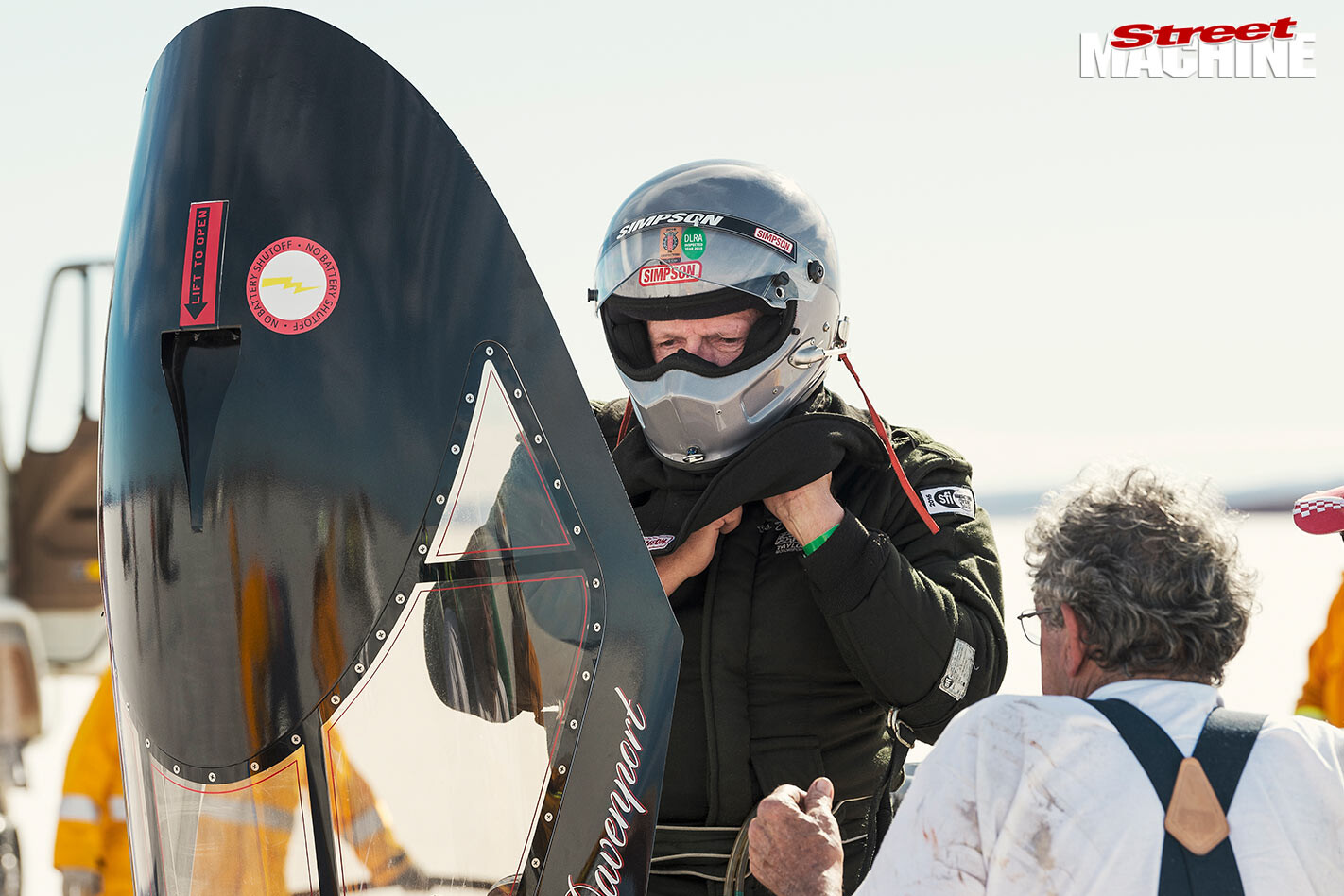 By contrast, the fastest bike is Richard Assen’s Assentec Special at 227mph, ahead of the turbo Suzuki Hayabusas of longtime DLRA competitors Ken Robinson (222mph) and Paul Powditch (218mph).
By contrast, the fastest bike is Richard Assen’s Assentec Special at 227mph, ahead of the turbo Suzuki Hayabusas of longtime DLRA competitors Ken Robinson (222mph) and Paul Powditch (218mph).
And the streamliners? When play resumes after lunch on Tuesday, Marlo Treit fires up Target 550 while Les Davenport dons his race clobber and eases himself into the cramped cockpit. The noise of two blown Hemis fast-idling on the five-mile Track 1 startline is something else, but nothing compared to when they explode into life once the push car has got them up to speed. Unfortunately, ‘explode’ is the operative word, as one engine drops a valve and fills a combustion chamber with shrapnel, but Davenport still records a 293mph pass on the remaining good engine. Only one person has ever gone faster at Lake Gairdner – John Lynch at 301mph in a bellytank in 2005 – and Treit has plenty of spares. They return late on Thursday and this time I head down to the pits, some three miles along the track, to see and hear it in full flight, thinking I may never see anything like it again. Reportedly on just 30 per cent throttle, Davenport goes an incredible 345mph, which looks as fast as it sounds. The pits erupt into applause when they eventually return, hootin’ and hollerin’ and blowin’ their horns as you’d expect.
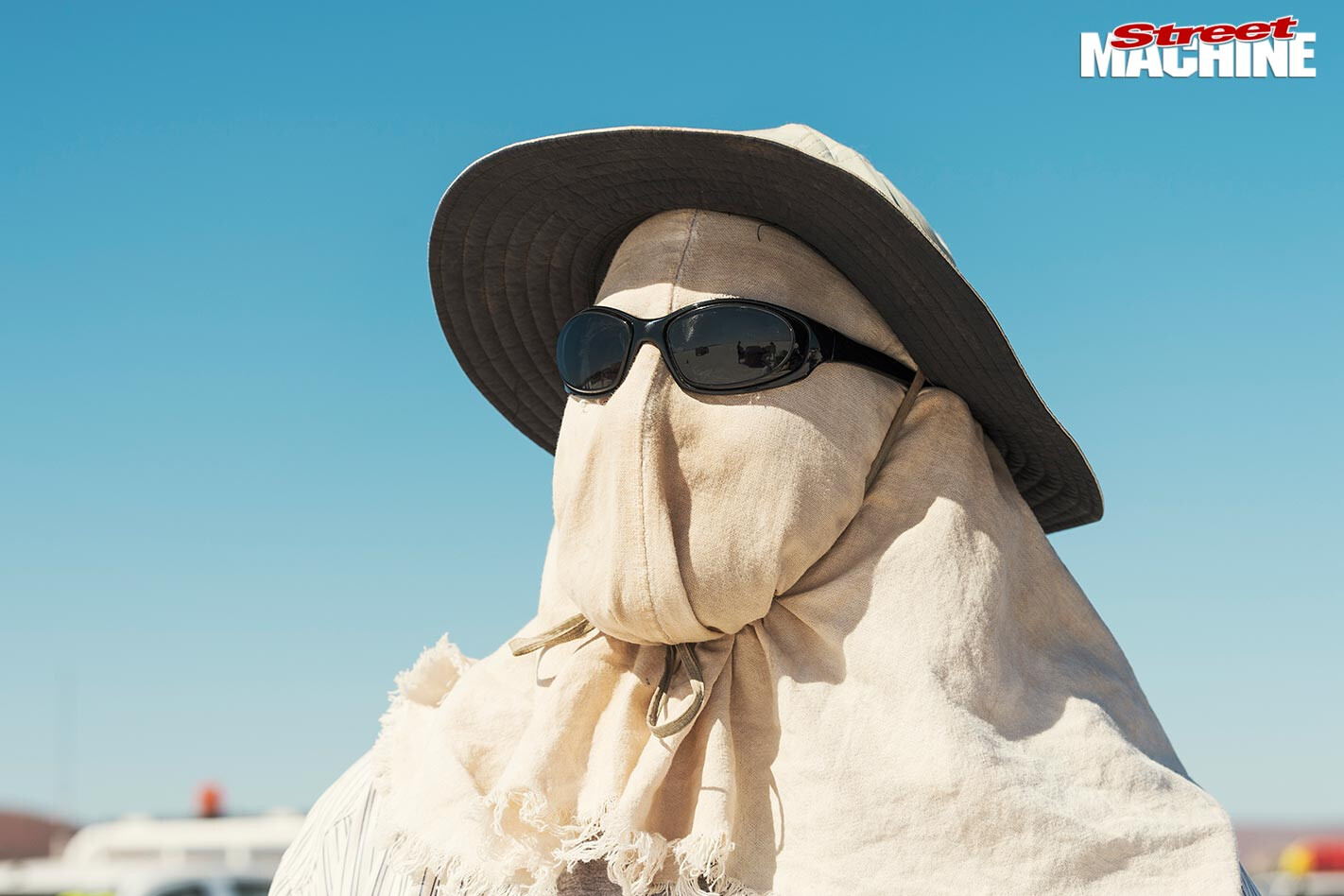 Target 550 makes one more trip to the startline late on Friday morning. Racing is scheduled to stop at lunchtime to give the DLRA time to prepare for the official World Land Speed Trials starting the next day, but this time the starters are happy to go hungry. Davenport is given the honour of the closing run of Speed Week, but sadly the transmission cries enough very early in the run and their Aussie adventure is over.
Target 550 makes one more trip to the startline late on Friday morning. Racing is scheduled to stop at lunchtime to give the DLRA time to prepare for the official World Land Speed Trials starting the next day, but this time the starters are happy to go hungry. Davenport is given the honour of the closing run of Speed Week, but sadly the transmission cries enough very early in the run and their Aussie adventure is over.
Despite the disappointment, Marlo Treit labels the trip a success. “We experienced some mechanical problems, but with Les Davenport guiding it, Target 550 ran 40mph faster than any car has ever run here, and we had the fastest speed for the meet,” he says. “We came home with no one sick, not even sunburnt, and the car can be repaired to run again.”
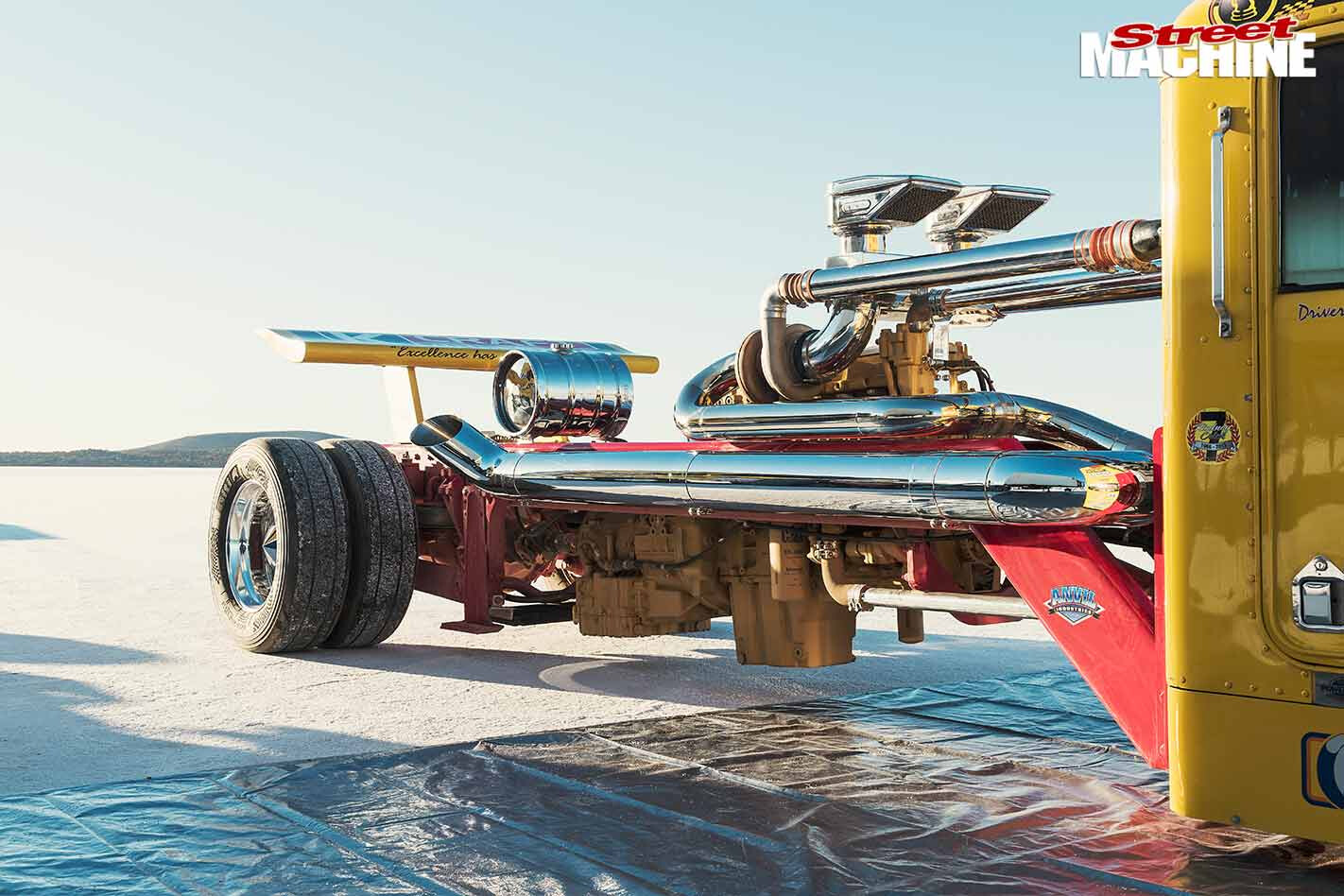 Meanwhile, Valerie Thompson aborts her first run in the Team 7 streamliner almost at the start, but gets it together for the next. The fastest-ever pass by a motorcycle in Australia is Rocky Robinson’s 289mph on an earlier Manning-built streamliner at Lake Gairdner way back in 2000. Running on just three cylinders and in third gear (of four), Valerie smashes it with a lazy 328mph to become the first motorcyclist to exceed 300mph in Australia, as well as the first woman.
Meanwhile, Valerie Thompson aborts her first run in the Team 7 streamliner almost at the start, but gets it together for the next. The fastest-ever pass by a motorcycle in Australia is Rocky Robinson’s 289mph on an earlier Manning-built streamliner at Lake Gairdner way back in 2000. Running on just three cylinders and in third gear (of four), Valerie smashes it with a lazy 328mph to become the first motorcyclist to exceed 300mph in Australia, as well as the first woman.
The team is understandably confident of a big show in the World Speed Trials that weekend, and Valerie is on point at 343mph at the four-mile mark on her first pass with eight miles to go, when the rear end suddenly lifts off the salt and she loses control. It’s all over in a heartbeat as Valerie deploys the parachutes to stabilise the machine, which then slides on its side for more than a mile before coming to a rest. “The best news is she walked away from it,” Denis Manning says. “All the safety stuff we designed worked. We know what happened; we now just have to work out why.”
 Both international teams are full of praise for Speed Week. Manning describes both the organisation of the event and the condition of the track as first class. “The DLRA did a marvellous job,” Treit adds. “Their scrutineers were very diligent and the safety crew members get the award for excellence and dedication.”
Both international teams are full of praise for Speed Week. Manning describes both the organisation of the event and the condition of the track as first class. “The DLRA did a marvellous job,” Treit adds. “Their scrutineers were very diligent and the safety crew members get the award for excellence and dedication.”
“The overwhelming comments from our international competitors was that our event was world class and that, given the opportunity, they would be back again,” says DLRA president Greg Wapling. “They were very impressed with the competency and diligence of our medical and rescue teams, and were amazed by the professionalism of the organisation and our volunteers.
“There was a real vibe this year and we – the collective, inclusive we – have put the world of land speed racing on notice. We can put on a world-standard event and have fun doing it.”
 READY RECKONER
READY RECKONER
With its roots in the US, land speed racing is all about miles per hour, never kilometres. Here’s how fast they’re really going:
100mph 160km/h
125mph 201km/h
150mph 241km/h
175mph 281km/h
200mph 321km/h
225mph 362km/h
250mph 401km/h
275mph 442km/h
300mph 482km/h
325mph 523km/h
350mph 563km/h
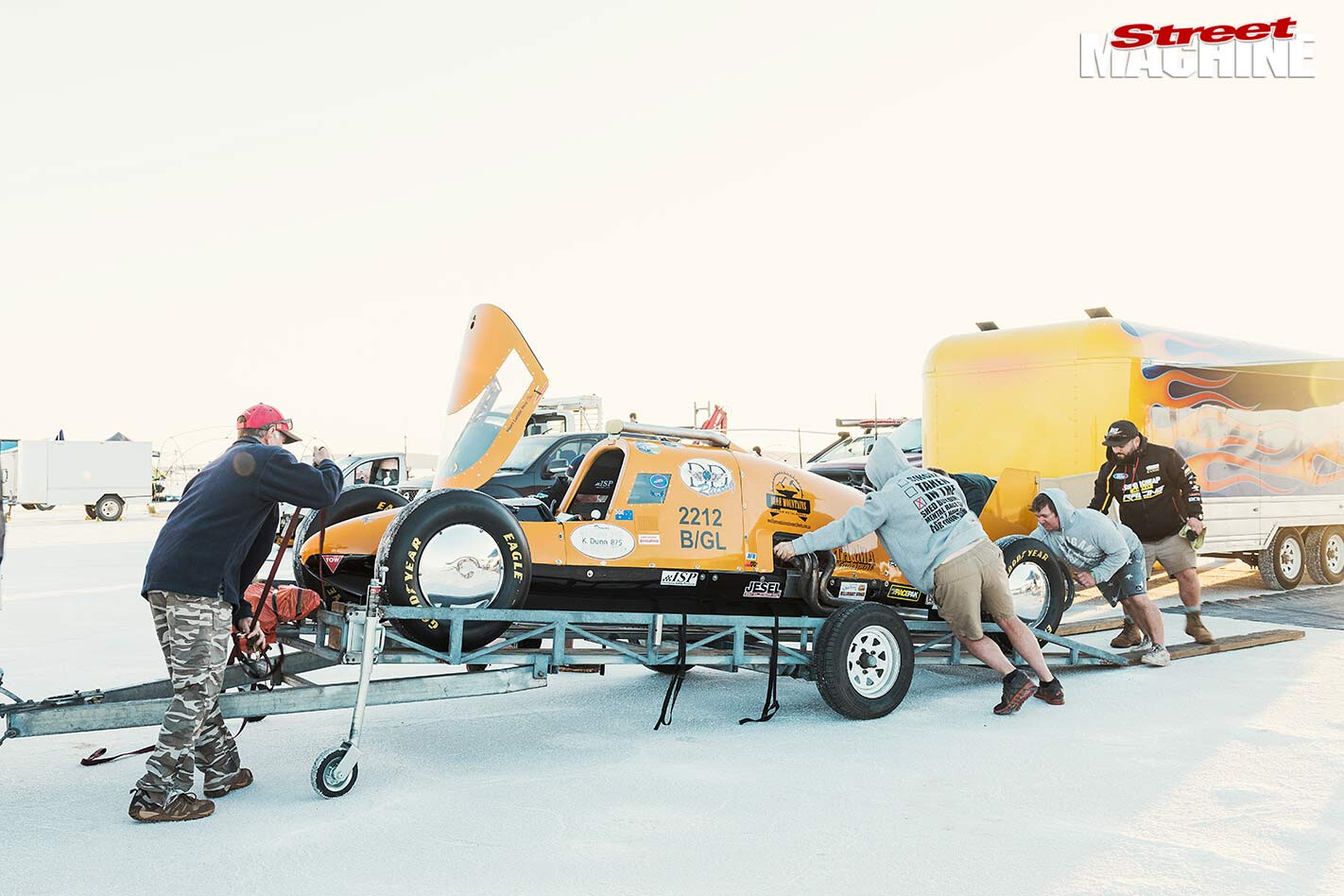 200mph CLUB
200mph CLUB
To join the 200mph Club, a competitor must exceed 200mph while setting a class record. The competitor is presented with a specially embroidered red hat.
Tony Cooke
Lakester 202.726mph
Mike Adi
Suzuki GSX-R1000 200.145mph
Stuart Goldsworthy
Kawasaki H2 207.230mph
Steve Strupp
Chev Camaro 239.330mph
Andy Freeman
Kawasaki H2 212.867mph
David Bullock
Lakester 214.082mph
200mph ACHIEVERS
The DLRA also recognises competitors who exceed 200mph for the first time but don’t set a record, with the presentation of a special DLRA red hat with black visor.
Tony Lam
Kawasaki H2 204.267mph
Craig Goldsworthy
Kawasaki H2 208.430mph
Lawrence May
Chev Camaro 238.001mph
 300mph CLUB
300mph CLUB
To join the 300mph Club, a competitor must exceed 300mph while setting a class record. The competitor is presented with a specially embroidered blue hat.
Valerie Thompson (above)
Streamliner 328.467mph
Les Davenport
Streamliner 345.125mp
 1. No surprise that John Dent’s bellytank was judged Best Presented Car; it looks magnificent, sounds like thunder and draws a big crowd every time it fires up. It’s also insanely fast, some 256mph in the cool hands of hotshot pilot Shaine Benson
1. No surprise that John Dent’s bellytank was judged Best Presented Car; it looks magnificent, sounds like thunder and draws a big crowd every time it fires up. It’s also insanely fast, some 256mph in the cool hands of hotshot pilot Shaine Benson
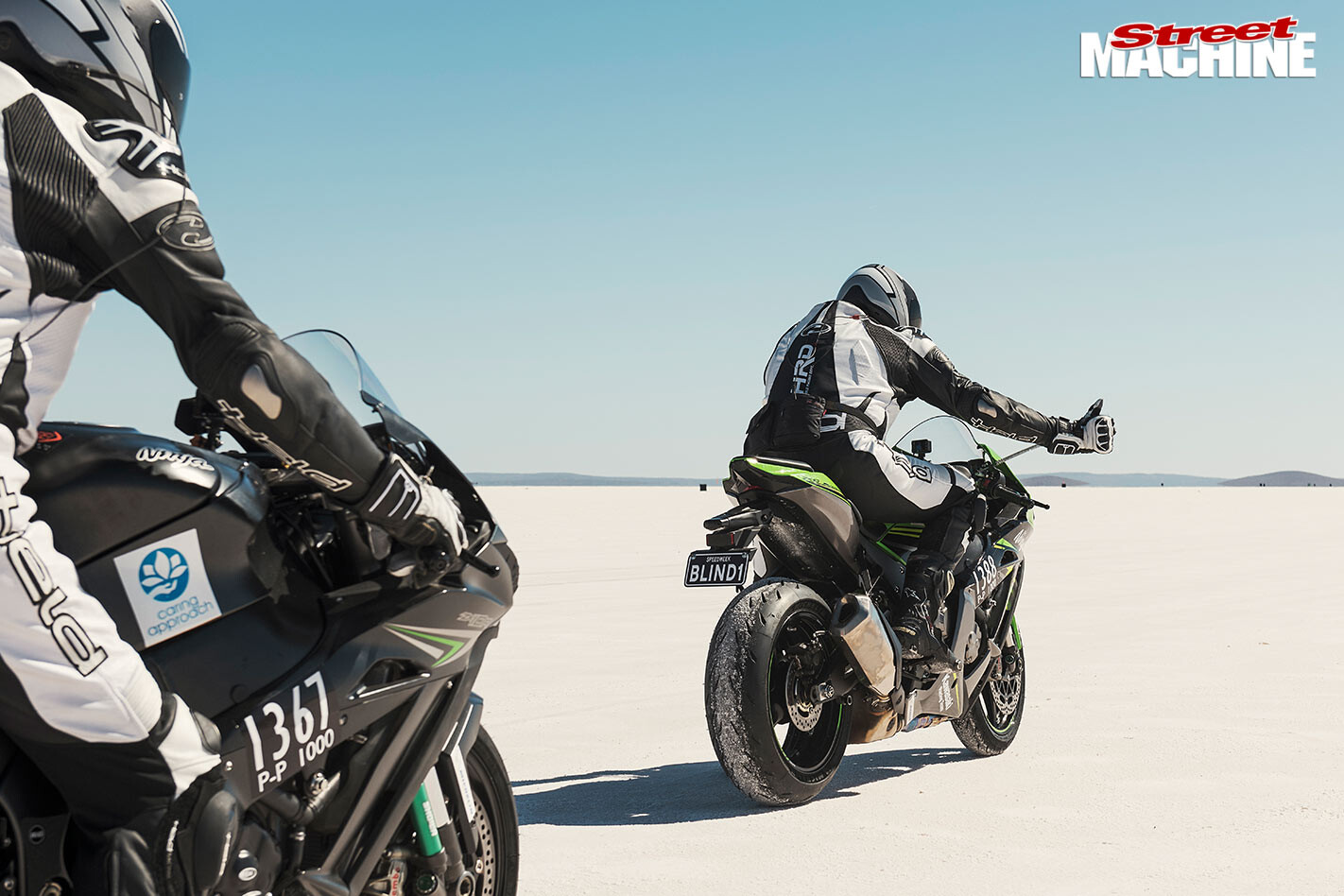 2. Ben Felten, who is totally blind, gives his wingman Kevin Magee (who guides Ben by radio) the thumbs-up ahead of a 155mph pass
2. Ben Felten, who is totally blind, gives his wingman Kevin Magee (who guides Ben by radio) the thumbs-up ahead of a 155mph pass
 3. Daryl Chalmers ran 207mph against his own 214mph record in the RATBAG Falcon
3. Daryl Chalmers ran 207mph against his own 214mph record in the RATBAG Falcon
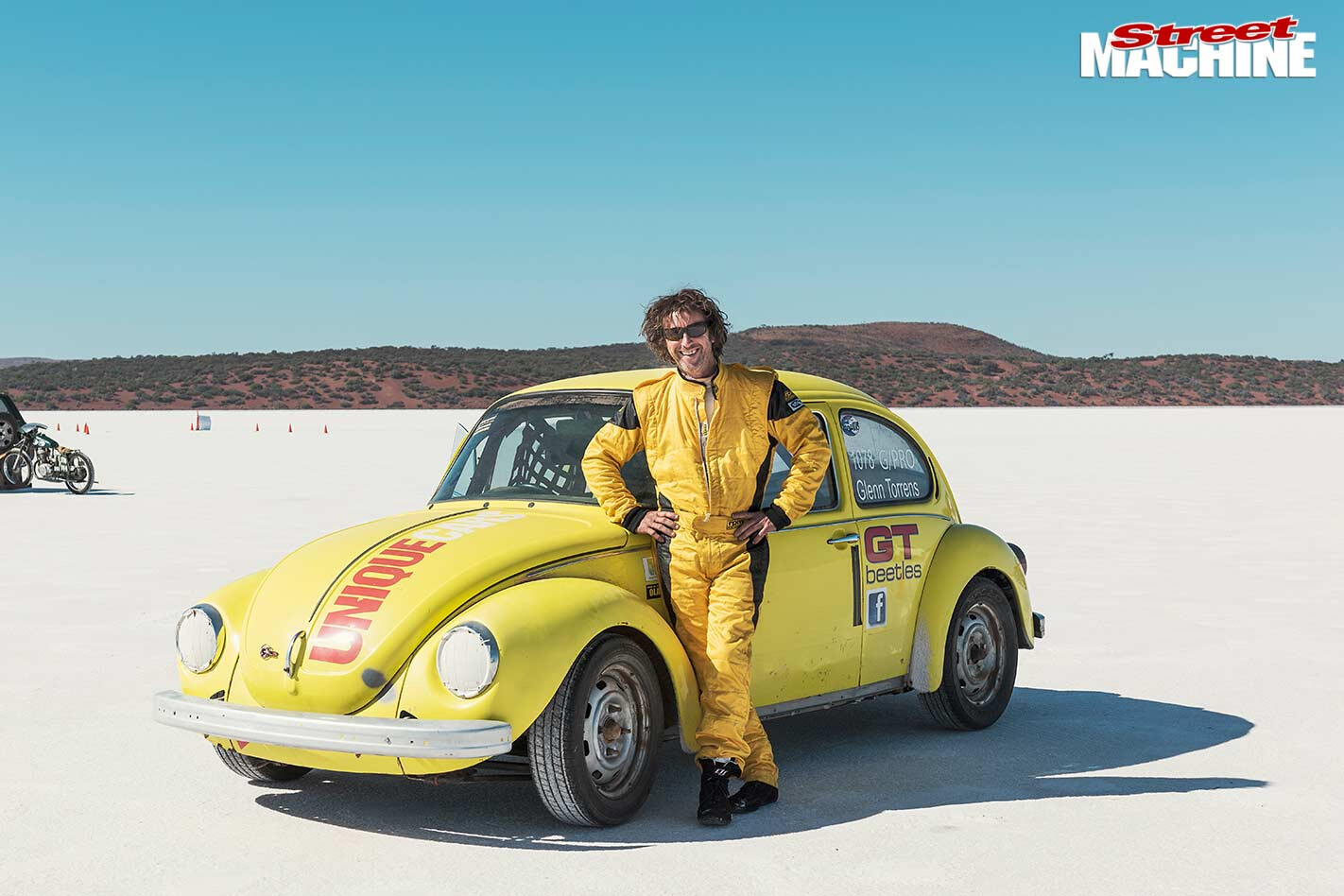 4. SM scribe Glenn Torrens is a regular competitor in his souped-up Superbug
4. SM scribe Glenn Torrens is a regular competitor in his souped-up Superbug
 5. Lionel West on his way to 270mph in the Bronze Aussie Commodore
5. Lionel West on his way to 270mph in the Bronze Aussie Commodore
 6. The legendary ‘Moe Boys’ XA Falcon returned after an eight-year absence, this time with David Nicholson aiming to beat his father Brian’s best of 198mph. With a fresh 900hp Clevo-style engine by Brian Cassar, David did just that, but missed out on the big prize with a frustrating 199.457mph
6. The legendary ‘Moe Boys’ XA Falcon returned after an eight-year absence, this time with David Nicholson aiming to beat his father Brian’s best of 198mph. With a fresh 900hp Clevo-style engine by Brian Cassar, David did just that, but missed out on the big prize with a frustrating 199.457mph
 7. Having come all the way from the US, Marlo Treit and Les Davenport weren’t messing about, running 345.125mph in their Target 550 streamliner – 40mph faster than any car has ever run at Lake Gairdner
7. Having come all the way from the US, Marlo Treit and Les Davenport weren’t messing about, running 345.125mph in their Target 550 streamliner – 40mph faster than any car has ever run at Lake Gairdner
 8. Jeff Jones made the 450km return trip to Port Augusta on Monday for parts to fix the noisy diff in his 1981 KE55 Corolla, only to find most of the town closed for a SA public holiday. He succeeded in the end to run 167mph with turbo V6 Commodore power
8. Jeff Jones made the 450km return trip to Port Augusta on Monday for parts to fix the noisy diff in his 1981 KE55 Corolla, only to find most of the town closed for a SA public holiday. He succeeded in the end to run 167mph with turbo V6 Commodore power
 9. Russell Diffey raced an Aussie-built replica of the 996cc Anzani, which set a new world land speed record of 108mph in 1923. Modern engine internals saw Russell go as fast as 155mph from 10 runs
9. Russell Diffey raced an Aussie-built replica of the 996cc Anzani, which set a new world land speed record of 108mph in 1923. Modern engine internals saw Russell go as fast as 155mph from 10 runs
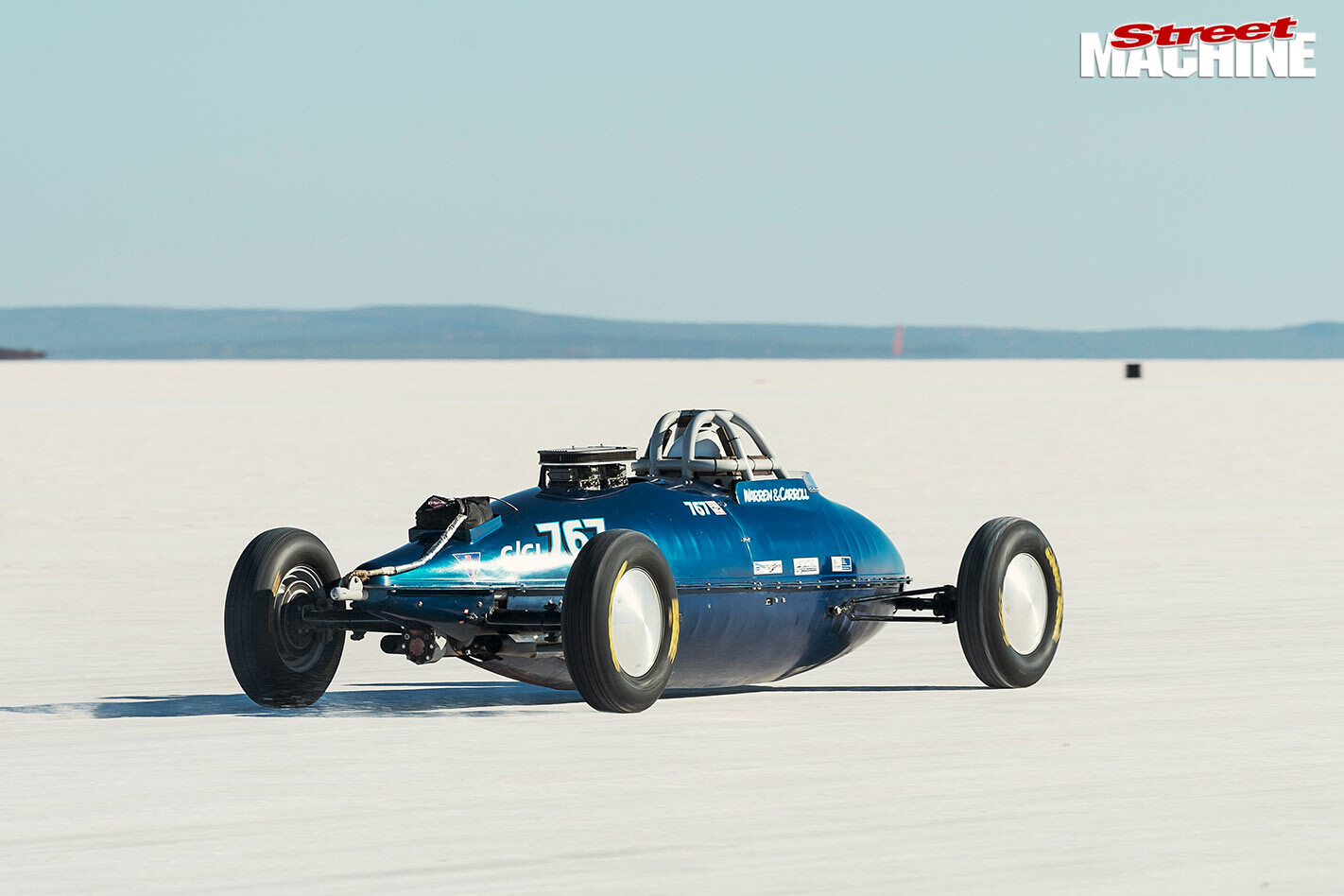 10. The Carroll-Warren bellytank looked and sounded the biz, but caught fire mid-track to bring their week to a sudden smoking halt
10. The Carroll-Warren bellytank looked and sounded the biz, but caught fire mid-track to bring their week to a sudden smoking halt
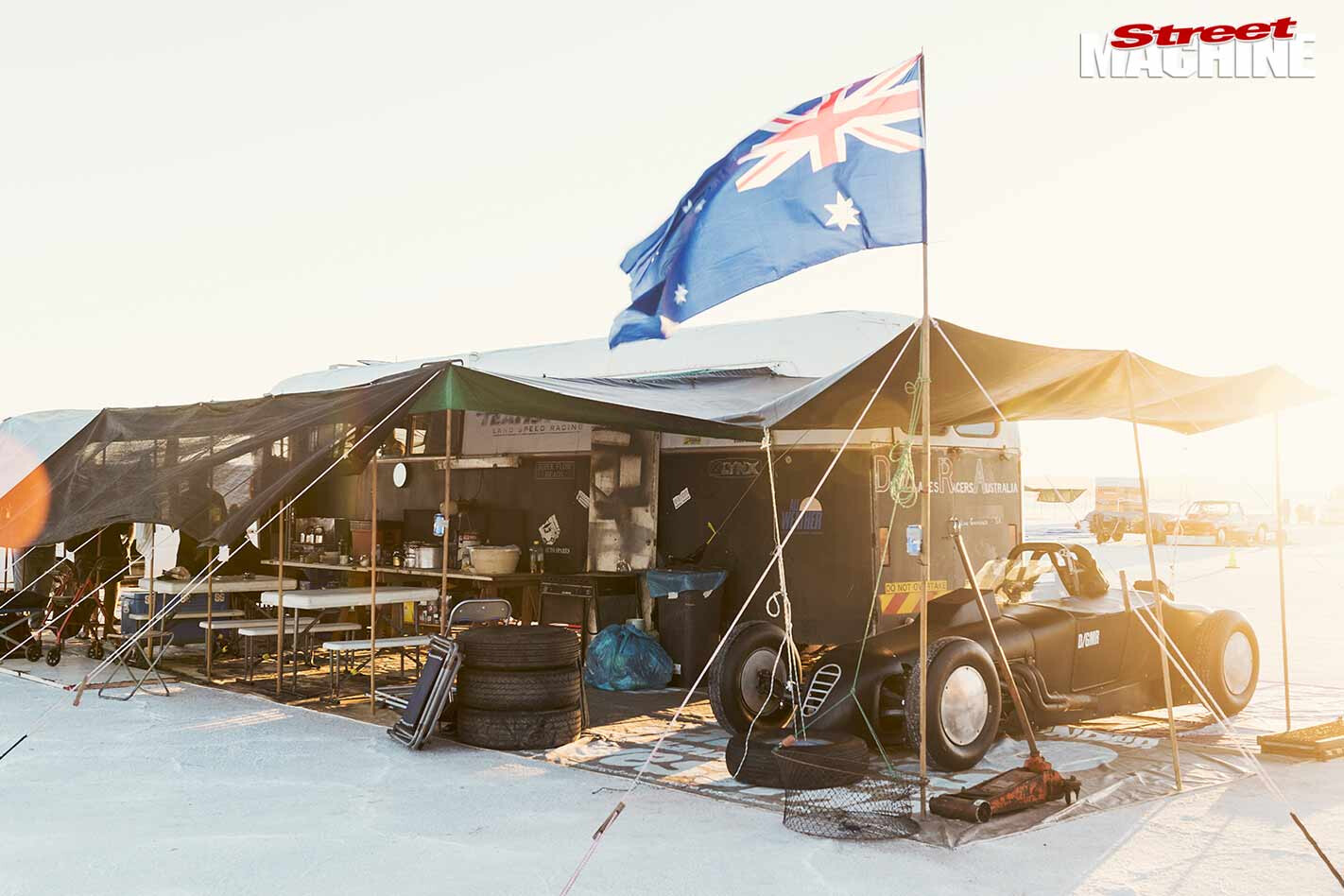 11. Veteran Bob Bowman has been racing his 1927 Ford roadster for decades, this year running 169mph against a 171mph record
11. Veteran Bob Bowman has been racing his 1927 Ford roadster for decades, this year running 169mph against a 171mph record
 12. Kiwis Dave Rosewarne and Mark Love swapped the engine, gearbox and diff of their ‘Chevrolet Firebird’ mid-week to run in different classes. It’s easier than bringing two cars, they reckon
12. Kiwis Dave Rosewarne and Mark Love swapped the engine, gearbox and diff of their ‘Chevrolet Firebird’ mid-week to run in different classes. It’s easier than bringing two cars, they reckon
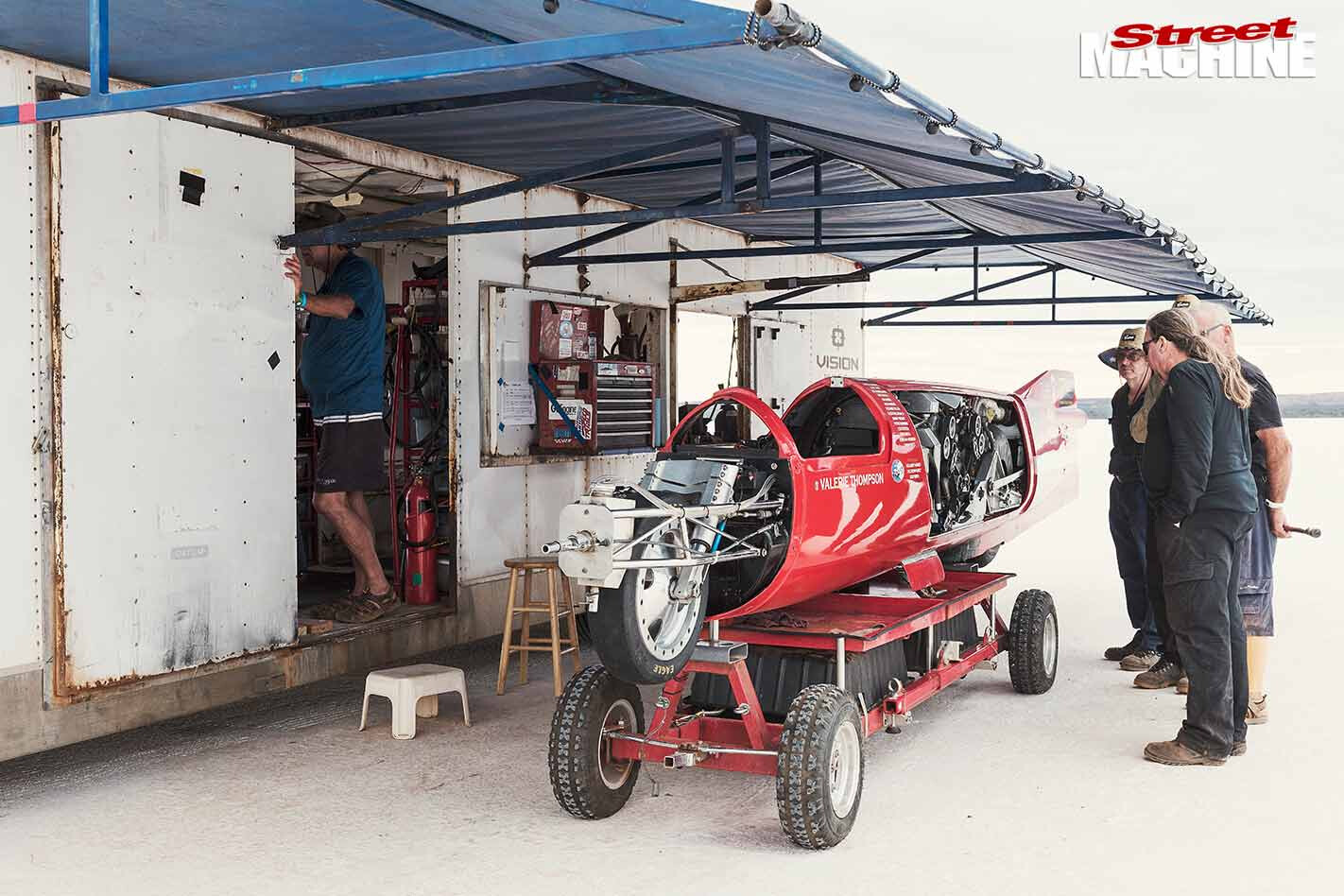 13. Triumph and heartbreak in equal measure for Valerie Thompson. After becoming the first motorcyclist and woman to exceed 300mph in Oz with a 328mph run at Speed Week, Valerie had a nasty stack during the subsequent World Speed Trials. Fortunately she was unhurt
13. Triumph and heartbreak in equal measure for Valerie Thompson. After becoming the first motorcyclist and woman to exceed 300mph in Oz with a 328mph run at Speed Week, Valerie had a nasty stack during the subsequent World Speed Trials. Fortunately she was unhurt
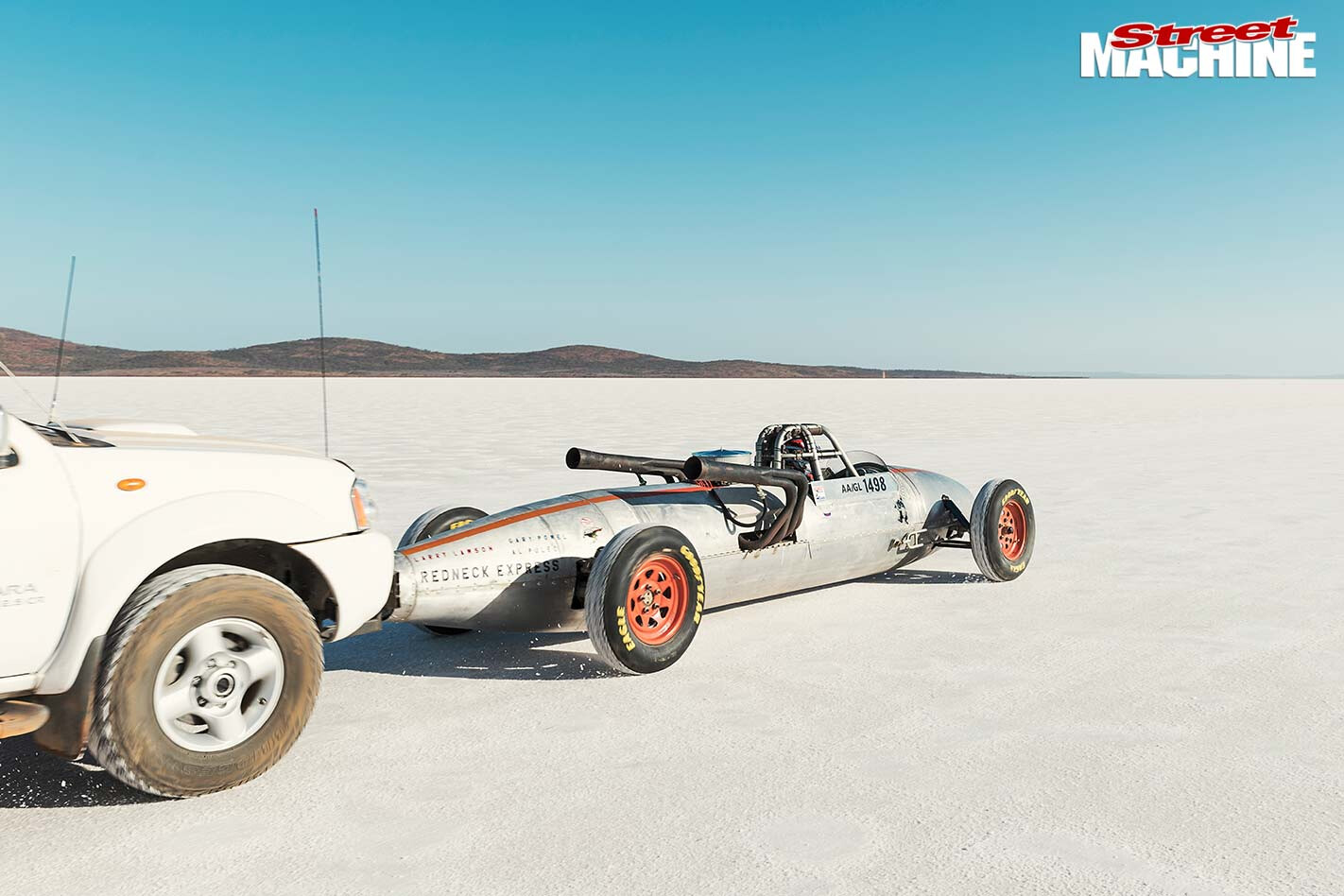 14. Wombat Racing acquired this lakester in the States as a roller last year and slotted in an 800hp BBC once home in sunny Mooroopna, Victoria. “It should be good for 200 if we can steer it,” Noel Heenan said at the start of the week. The lakester didn’t miss a beat over 12 runs in four days with three rookie drivers aboard, the best being David Bullock at 214mph
14. Wombat Racing acquired this lakester in the States as a roller last year and slotted in an 800hp BBC once home in sunny Mooroopna, Victoria. “It should be good for 200 if we can steer it,” Noel Heenan said at the start of the week. The lakester didn’t miss a beat over 12 runs in four days with three rookie drivers aboard, the best being David Bullock at 214mph
 15. It wasn’t a great week for Norm Hardinge in the refurbished Big Knob Racing 1934 roadster. His all-new BBF engine expired at more than 200mph on its first run
15. It wasn’t a great week for Norm Hardinge in the refurbished Big Knob Racing 1934 roadster. His all-new BBF engine expired at more than 200mph on its first run
 16. Race Director’s Pick went to Rob Waters’ 1977 W-Series ‘Gold Nugget’ Kenworth. “We built it in our own [truck] workshop from stuff lying around,” Rob says. Build time was five months, and the beast ran a best on debut of 137mph against a 155mph record. One to watch next year for sure
16. Race Director’s Pick went to Rob Waters’ 1977 W-Series ‘Gold Nugget’ Kenworth. “We built it in our own [truck] workshop from stuff lying around,” Rob says. Build time was five months, and the beast ran a best on debut of 137mph against a 155mph record. One to watch next year for sure
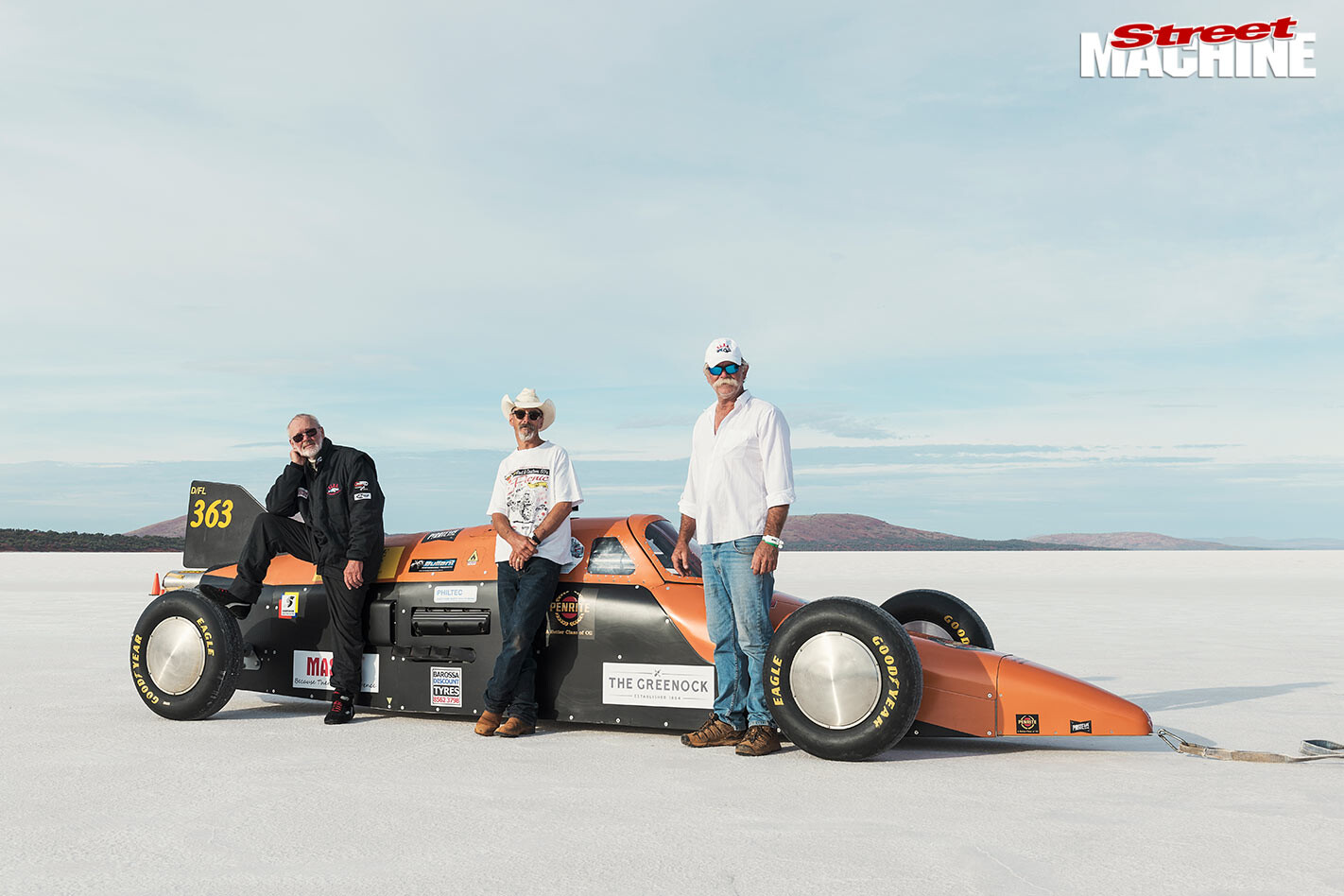 17. Long time DLRA member Tony Cooke joined the 200mph Club in only his second year racing his lakester. Against his own 180mph record, he ran faster than 200mph on four of seven runs with a best of 202.726mph
17. Long time DLRA member Tony Cooke joined the 200mph Club in only his second year racing his lakester. Against his own 180mph record, he ran faster than 200mph on four of seven runs with a best of 202.726mph
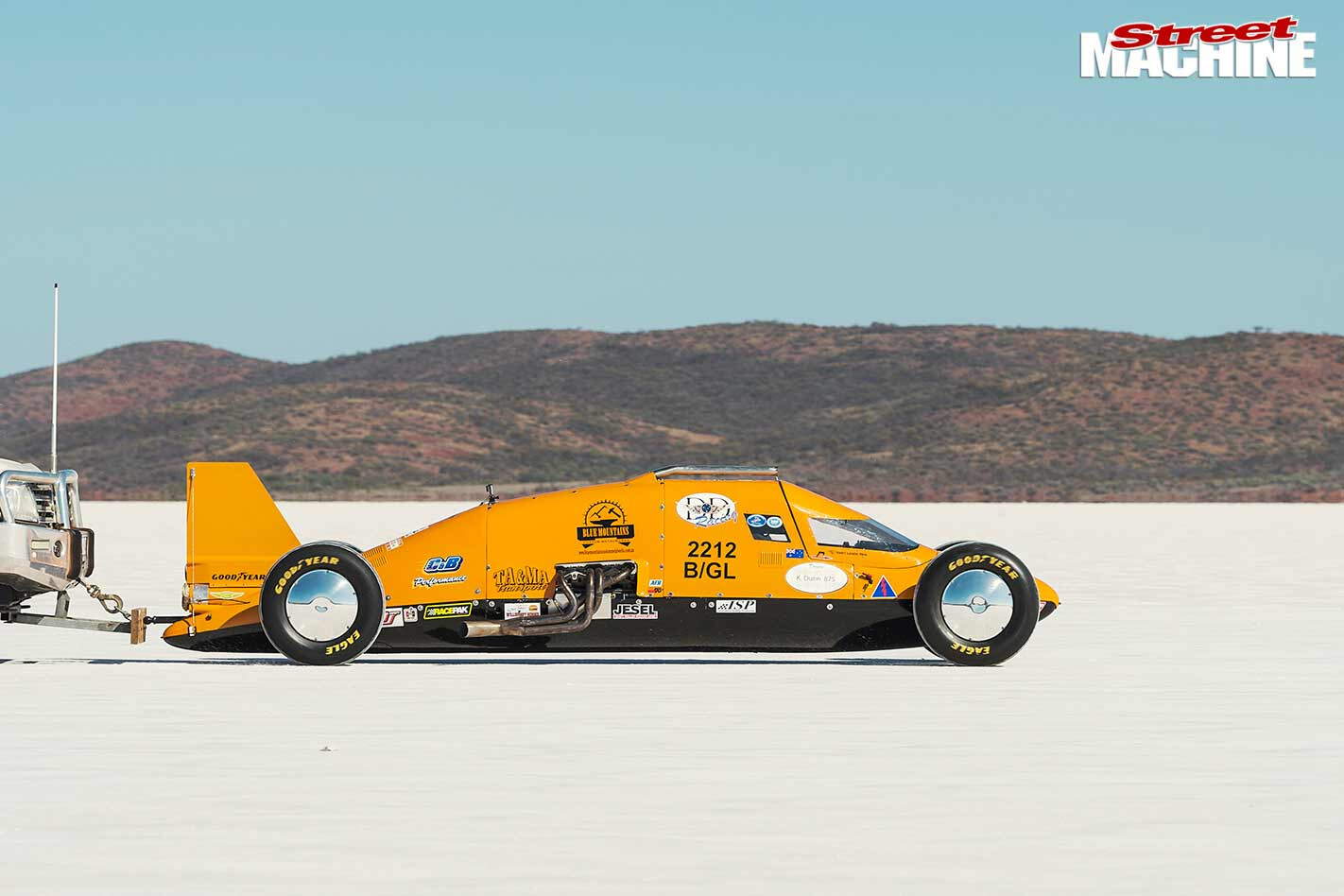 18. The Dunn family are DLRA stalwarts in their lakester, with many family members racing it over the years. This time around, Kurt Dunn at 243mph was too good for dad Mark at 238mph
18. The Dunn family are DLRA stalwarts in their lakester, with many family members racing it over the years. This time around, Kurt Dunn at 243mph was too good for dad Mark at 238mph
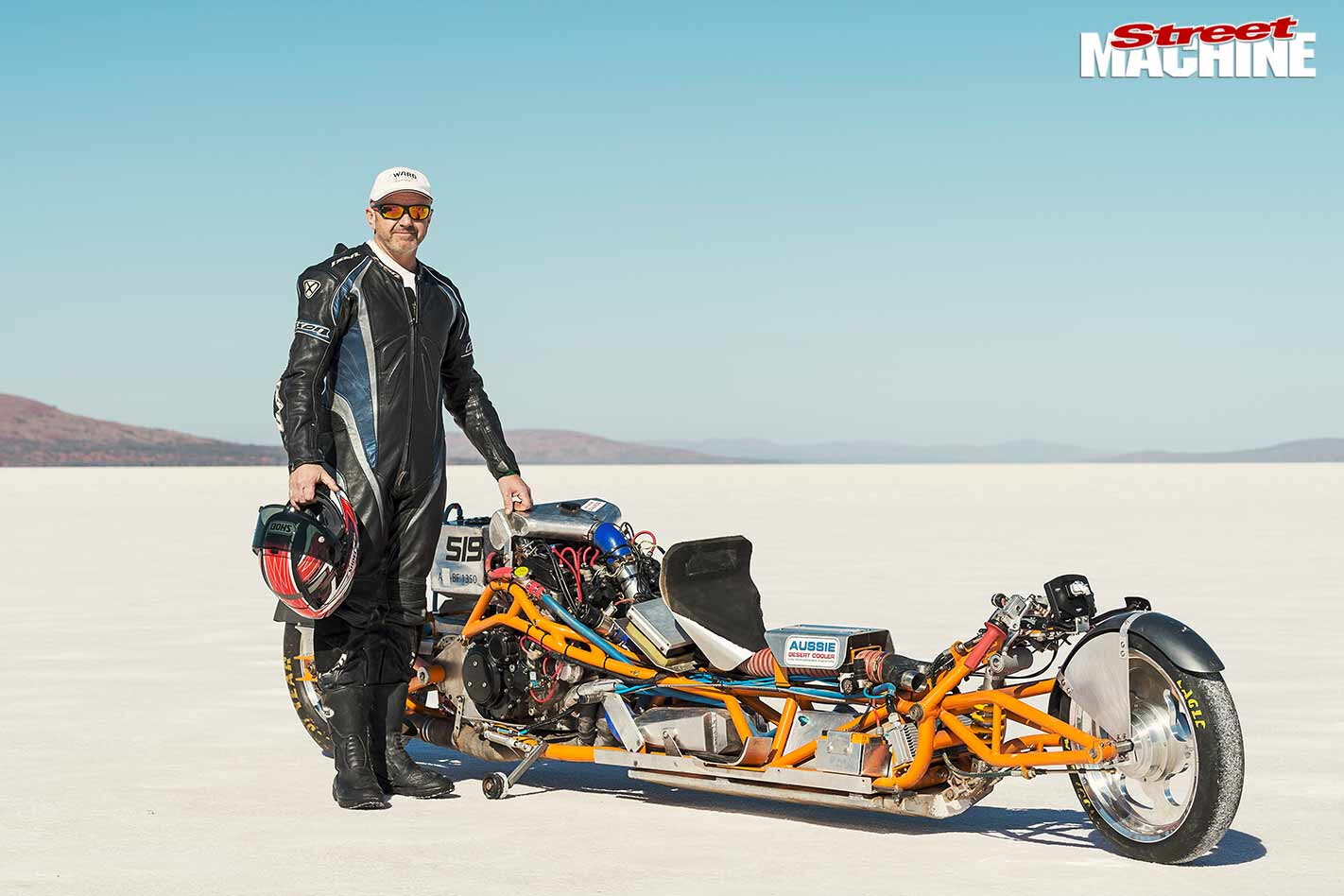 19. Fastest bike of the meeting was Richard Assen’s Hayabusa-powered special at 227.187mph
19. Fastest bike of the meeting was Richard Assen’s Hayabusa-powered special at 227.187mph
 20. Keely Bown has been racing drift circuit since she was 12. She is now also an accomplished land speed racer, smashing her own 142mph record with a blistering 169mph pass in her 1994 Subaru
20. Keely Bown has been racing drift circuit since she was 12. She is now also an accomplished land speed racer, smashing her own 142mph record with a blistering 169mph pass in her 1994 Subaru
 21. Steve Morgan set a 152mph class record years ago in the 302ci Boss-powered Toyota HiLux he shares with John Viles, and the pair have been chasing it ever since. John was closest in 2018 with 149mph
21. Steve Morgan set a 152mph class record years ago in the 302ci Boss-powered Toyota HiLux he shares with John Viles, and the pair have been chasing it ever since. John was closest in 2018 with 149mph
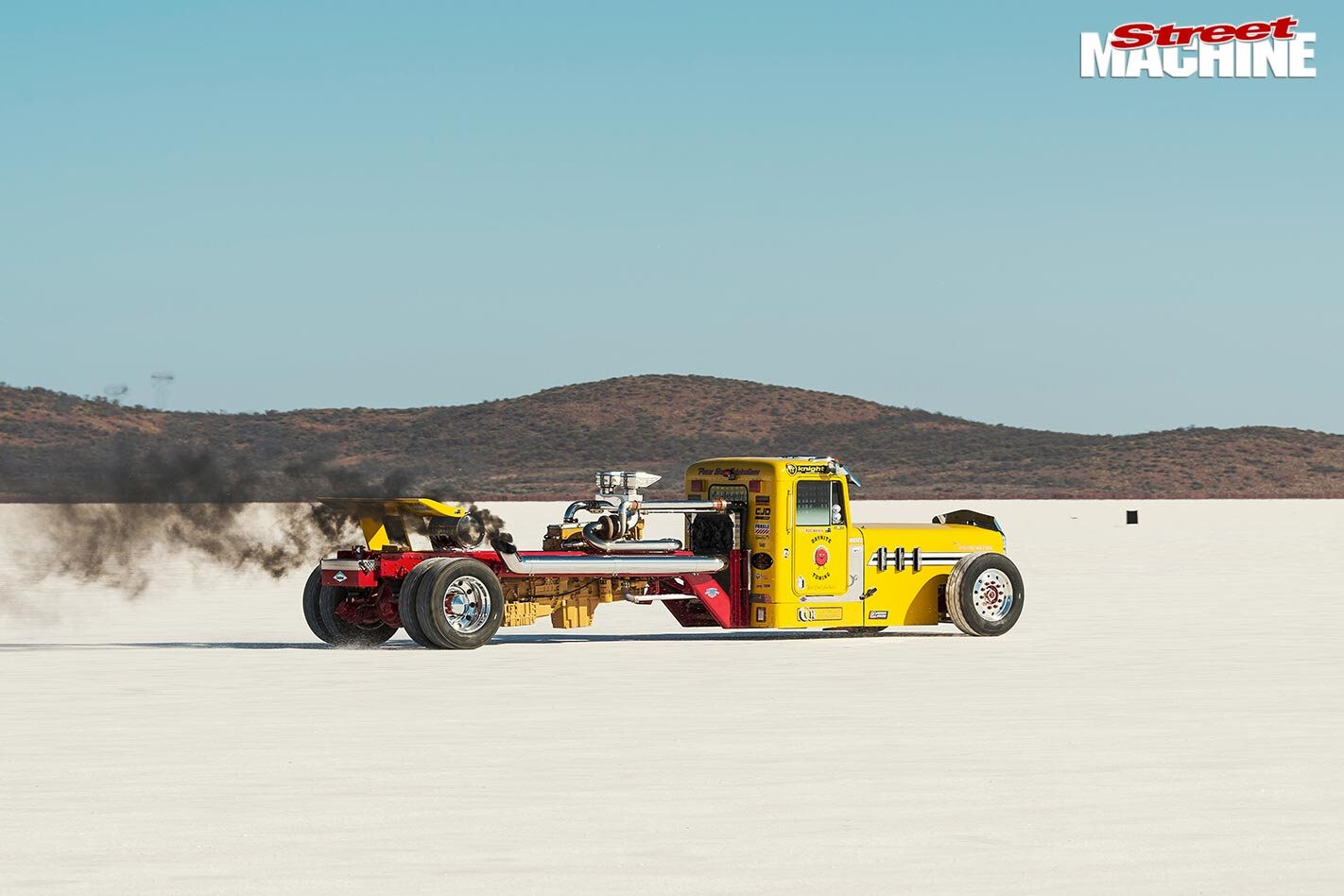
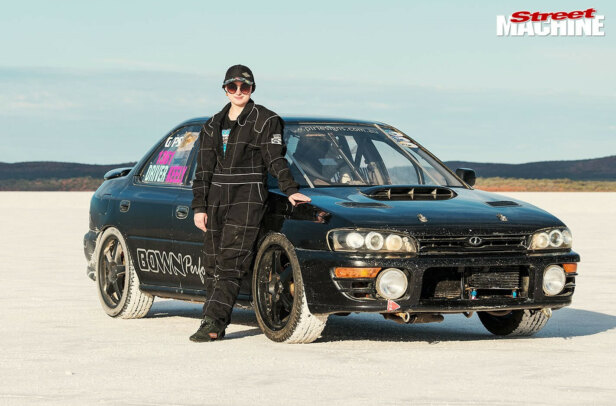

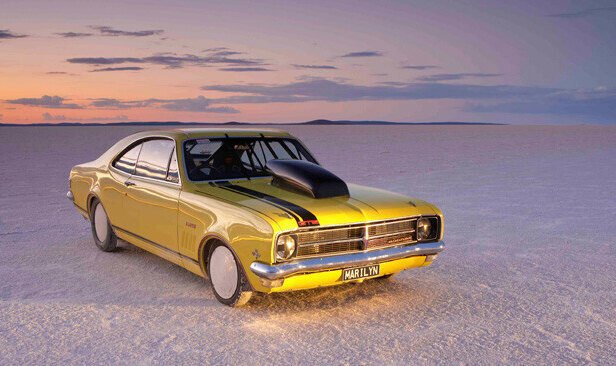
Comments